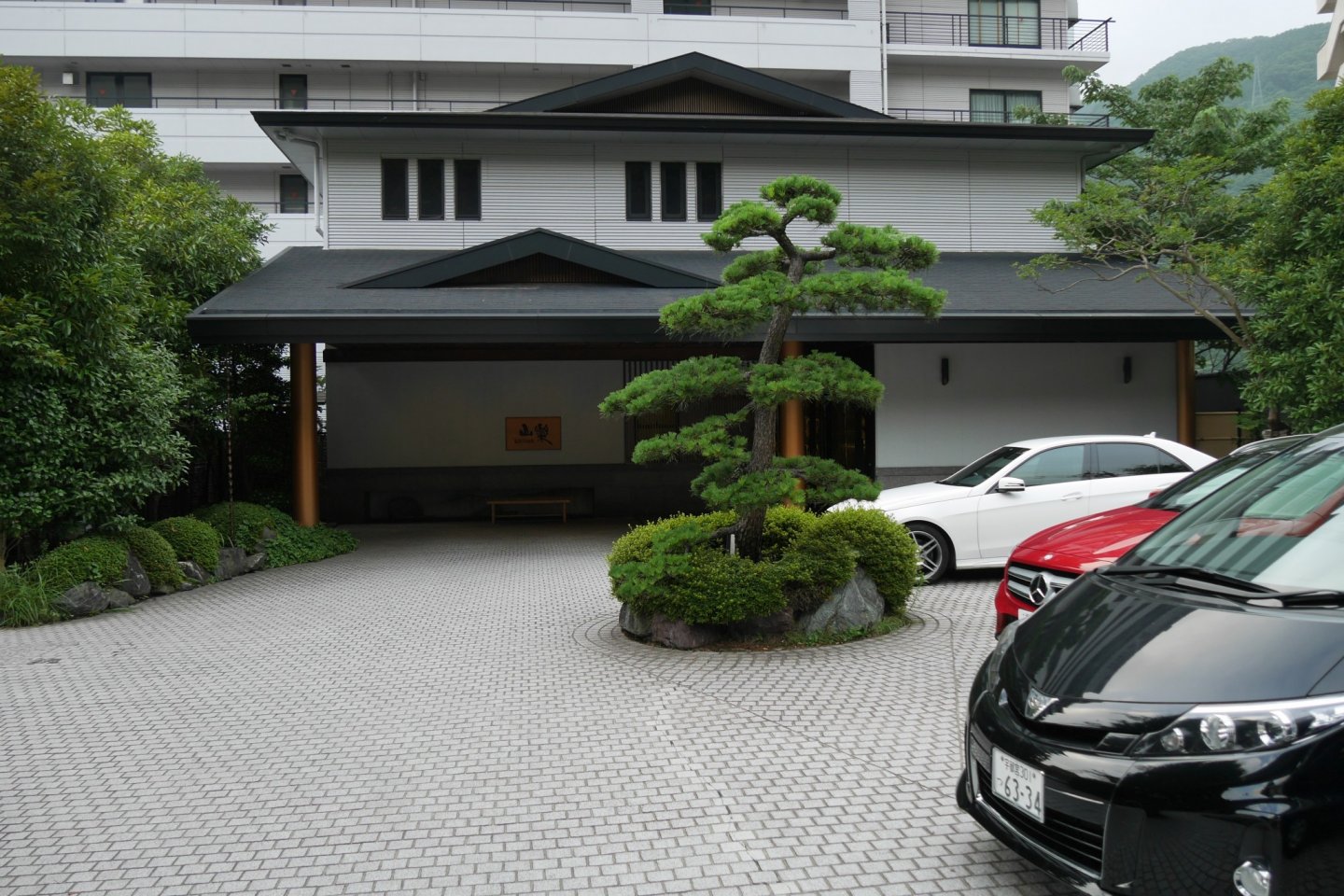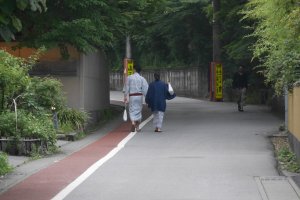Kinugawa is an onsen town about 17km to the north of Nikko. It’s an easy drive, or cycle, in my case, and unlike hyperactive Nikko it is best used as a place for relaxing and dining. The hot springs were first discovered in the 1600s by local villagers, and in the Meiji era (1868 to 1912) Kinugawa became popular as a countryside retreat for well-heeled Tokyoites. Then, in 1927, the Tobu rail company completed an electrified line connecting Tokyo’s Asakusa with Kinugawa, allowing people of all classes to come hike the surrounding mountains then enjoy the health-giving spa waters afterwards.
Actually, Kinugawa in Japanese means “angry demon”, no doubt referring to the whitewater rapids downstream of the onsen area. You can boat/raft these rapids, and it’s quite a sight seeing the local boat owners delivering their canoes down a steep hillside, dangling in mid-air by rope and lifting tackle.
I stayed at the Kinugawa Onsen Sanraku Hotel, an upmarket but reasonably priced onsen hotel that like its brethren, clings to the east side of the Kinugawa river. You can’t fail to find the Sanraku, because it’s located right next to the famous Taisho era (1912-1926) Kinugawa Onsen Fureai Bridge. This pedestrian-only bridge provides a commanding overhead view of the raging torrent below. Great location for taking photos!
My first impression when I arrived at the Kinugawa Onsen Sanraku Hotel was the level of care and attention given to all the public areas. The driveway features a beautifully manicured miniature pine that makes for a perfect backdrop for group photos. The entrance hall is spacious with high ceilings, and there are curios and art of all kinds festooning the walls and alcoves. At the far end of the lobby is the lounge, with huge viewing windows looking out on to the river and the verdant mountains on the opposite side.
At Reception I was given a Japanese-style room with tatami floors since I prefer sleeping on futon, but the Sanraku also has western rooms as well. Each room is huge, starting at 74 sq. m., and comes with a great view, so you’re not going to be disappointed facilities-wise. But, be prepared to book well ahead or stay on weekdays. Weekends get busy due to the steady flow of overnight Japanese visitors from Tokyo’s suburbs.
Like any well-run onsen in Japan, the room comes with the usual tea, welcome snack – very yummy manju (sweet Japanese pastry), shampoos, towels, yukata kimono, and other amenities. What was noticeably better than some other places was the pampering I got from my assigned “Nakai-san” (room attendant) who was impeccably dressed in traditional kimono and bowed so many times while serving me that I almost felt embarrassed. Of course I knew that she was practicing “omotenashi” (deep hospitality) and so it was an interesting cultural moment for me. Several of the staff at Sanraku are bilingual, so you don’t have to worry missing the explanations.
The futons were comfy, the rooms all came with free high-speed Wi-Fi, which is important to me since even on holiday I have to check my email – but the real draw was the wall-to-wall sliding windows looking out over the Kinugawa river. The windows open on to a small terrace, and so you can step out to hear and watch the rushing water. The dull roar is both impressive and yet soothing – making the luxury of being safe and sound inside even more tangible.
The sight of rushing water reminded me that this is an onsen after all, so what were the Sanraku baths like? I changed into my XL-sized yukata (largest sized – I’m 186cm tall) and slip slopped my way down to the Ofuro (baths) area. There were of course two entrances, and if you can’t read Kanji, the Men’s bath almost always has a blue curtain. Sanraku’s ofuro is on the first floor of the building, and has both an inside and outside bath. The water is taken from the hillside over the other side of the river, and Kinugawa is noted for its soft and odor-free water. I most appreciated floating around in the outdoor bath, peering through the modesty slats to view the river and hillside opposite. I must have been in there for a good hour, because I lost track of time then suddenly realized I’d booked dinner for 18:30. I jumped out, washed down once more quickly, then padded back up to my room.
Dinner is probably the highlight of staying at the Sanraku. You can choose to either eat in-room or down in the dining area. I was tired after a long journey and wanted to take it easy, so I chose to eat in the room. I have to say that the feast brought in to me was one of the best I’ve had in my many visits to onsen in Japan. The kaiseki dinner consisted of 6 or 7 courses—actually I forget just how many—and each one was delicious and meticulously prepared. My favorite was the Tsubugai (Whelk) shellfish done in a light truffle sauce – yes, real truffles! The dish was so exquisite that I couldn’t help asking the next morning if the chef, could share the recipe, which he very kindly did!
Recipe for Tsubugai truffle miso (By Chef Kanta Fukumoto)
Ingredients: Taihaku miso (a kind of sweet white miso), sake, red wine, butter, real truffles
Method: Peel, then mince an onion. Mix in the remaining ingredients to taste. Take the mixture and ply around the shellfish in the shell, brush with soy sauce, then grill.
Delicious!
To get to Kinugawa Onsen Sanraku Hotel, you can catch the hourly Tobu Limited Express Spacia bound for Kinugawa from Kitasenju for JPY2,700. The trip takes about 2 hours and after alighting at Kinugawa Onsen Station, the Sanraku’s free shuttle will come pick you up. You can also rent a car in Nikko and drive across the mountain to Kinugawa, or do like I did, and carry your bicycle in a purpose-made “rinko-bukuro” (bicycle bag) on the train, then alight at Nikko and ride the rest of the way there.



































